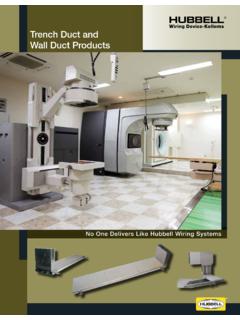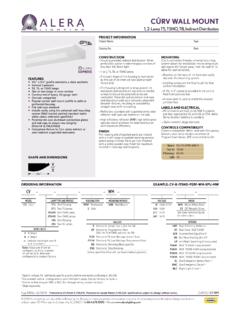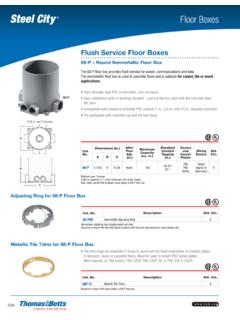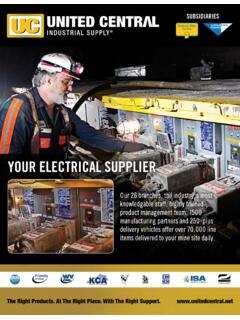Transcription of LOAD TESTS - HCI
1 load TESTSPage B-1 | hubbell Power Systems, Inc. | All Rights Reserved | Copyright 2014 load TESTSPage B-2 | hubbell Power Systems, Inc. | All Rights Reserved | Copyright 2014FS ..Factor of Safety B-3PT ..Test Pressure B-3DL ..Design load B-3A ..Effective Cylinder Area B-3AL ..Alignment load B-4 ASTM ..American Society for Testing and Materials B-6D ..Diameter B-6 STATIC load TESTS (TIEBACKS) .. B-3 STATIC AXIAL load TESTS (COMPRESSION/TENSION) .. B-6 STATIC load TESTS (LATERAL) .. B-9 CAPACITY VERIFICATION FOR ATLAS RESISTANCE PIERS .. B-10 ACCEPTANCE CRITERIA .. B-12 CONTENTSLOAD TESTSAppENDix BSYMBOLS USED iN THiS SECTiON DISCLAIMERThe information in this manual is provided as a guide to assist you with your design and in writing your own specifications. Installation conditions, including soil and structure conditions, vary widely from location to location and from point to point on a engineering analysis and consulting state and local building codes and authorities should be conducted prior to any installation to ascertain and verify compliance to relevant rules, regulations and Power Systems, Inc.
2 , shall not be responsible for, or liable to you and/or your customers for the adoption, revision, implementation, use or misuse of this information. hubbell , Inc., takes great pride and has every confidence in its network of installing contractors and dealers. hubbell Power Systems, Inc., does NOT warrant the work of its dealers/installing contractors in the installation of CHANCE Civil Construction foundation support TESTSPage B-3 | hubbell Power Systems, Inc. | All Rights Reserved | Copyright 2014 STATIC load TESTS (TIEBACKS)TEST PROCEDUREWARNING! DO NOT ALLOW ANYONE TO STAND BEHIND OR IN LINE WITH THE THREADED BAR AND JACK DURING THIS TEST. SERIOUS INJURY MAY OCCUR IF A COMPONENT FAILS DURING Determine the required length of the helical tieback anchor to locate the helix plates into the target soil stratum as determined from the project boring logs.
3 Use this data to select the tieback design and ultimate tension capacity and the estimated installation torque. Install the helical tieback anchor to the determined length and torque If the soil overburden has not been excavated from behind the wall, connect the thread bar adapter/transition to the helical tieback by reaching through the hole in the wall. Install the continuously threaded bar, reaction channel, hydraulic ram (loading device), pretension frame (if required), dial indicator (or other measuring device such as Total Station Unit), hydraulic pump and gauge (see Figure B-1). The magnitude of the test pressure is determined as follows:PT (test pressure) psi = DL (design load ) lbs x FS (Factor of Safety = to ) A (effective cylinder area) in2 NOTE: The effective cylinder areas (A) are available from the manufacturers of center hole rams ( , Enerpac, Power Team, Simplex, etc).
4 The load application system, , center hole ram and pump, shall be calibrated by an independent testing agency prior to the load testing of any tiebacks. For additional details, refer to the Model Specification - Helical Tieback Anchors for Earth Retention at Configuration for Performing a load Test on a Retaining Wall or to Pretension a Wall with Soil B-1It is recommended that the Field load Tieback Test be conducted under the supervision of a Registered Professional Engineer. The engineer will specify the test and measurement procedure, load increments, time intervals and acceptable ultimate deflection consistent with specific project and load conditions. If the required ultimate load and test ultimate load results are close, the engineer may choose to adjust the tieback spacing, the length of installation to achieve greater installation torques, and/or the helical plate configuration on each tieback to achieve the desired Factor of Safety (FS).
5 load TESTSPage B-4 | hubbell Power Systems, Inc. | All Rights Reserved | Copyright 2014 An Alignment load (AL), usually 5% to 10% of the Design (Working) load (DL), should be applied to the helical tieback anchor prior to the start of field load TESTS . The initial alignment load helps to remove any looseness in the tieback shaft couplings and thread bar transition Pre-Production TESTS (Optional): load TESTS shall be performed to verify the suitability and capacity of the proposed helical tieback anchor, and the proposed installation procedures prior to the installation of production tiebacks. The owner shall determine the number of pre-production TESTS , their location and acceptable load , and movement criteria. Such TESTS shall be based, as a minimum, on the principles of the performance test as described below. If pre-production tiebacks are to be tested to their ultimate capacity, then an additional purpose of the pre-production TESTS is to empirically verify the ultimate capacity to average installing torque relationship of the helical tiebacks for the project site.
6 Testing above the performance test maximum applied load of 125% x DL should follow the loading procedures and increments as given in the Static Axial load TESTS (Compression/Tension) section to Performance TESTS : The number of tiebacks that require performance testing shall be defined in the project specifications. The minimum number of tiebacks for performance testing shall be two (2). Helical tieback anchors shall be performance tested by incrementally loading and unloading the tieback in accordance with the Performance Test Schedule (see Table B-1). The applied load shall be increased from one increment to the next immediately after recording the anchor movement. The load shall be held long enough to obtain and record the movement reading at all load increments other than the maximum test load . The maximum test load ( x DL) shall be held for a minimum of 10 minutes. Anchor movements shall be recorded at , 1, 2, 3, 4, 5, 6, and 10 minutes.
7 Refer to Acceptance Criteria on page B-12 for additional hold periods, if required, and acceptable movement Proof Testing: All anchors which are not performance tested shall be proof tested. The proof test shall be performed by incrementally loading the helical anchor in accordance with the Proof Test Schedule (see Table B-2). The load shall be raised from one increment to another after an observation period. At load increments other than the maximum test load , the load shall be held for a period not to exceed two (2) minutes. The two minute observation period shall begin when the pump begins to load the anchor to the next load increment. Movement readings shall be taken at the end of the two minute observation period. The dealer/installing contractor or engineer shall plot the helical anchor displacement vs. load for each load increment in the proof test. The test load shall be maintained for five (5) minutes.
8 This five minute observation period shall commence as soon as is applied to the anchor. Displacement readings shall be recorded at , 1, 2, 3, 4, and 5 minutes. Refer to Acceptance Criteria on page B-12 for additional hold periods, if required, and acceptable displacement Tension load Test in Minneapolis, MNFigure B-2 load TESTSPage B-5 | hubbell Power Systems, Inc. | All Rights Reserved | Copyright 2014 PERFORMANCE TEST SCHEDULECYCLICAL load INCREMENTS (%DL/100) * * * *Reduce to lock-off load #AL = Alignment load , usually 10 to 15% of = Design (Working) load * The dealer/installing contractor shall plot the helical anchor movement for each load increment marked with an asterisk (*) in the performance schedule and plot the residual displacement at each alignment load versus the highest previously applied load .# Helical tieback anchors which are performance tested may be completely unloaded prior to the lock-off load procedure.
9 Final adjusting to the lock-off load does not require further movement the Performance Testing Procedures in the Model Specification - Helical Tieback Anchors for Earth Retention at for further information regarding load test equipment, load test set-up, dial gauges for monitoring anchor displacement, Test Schedule, Table B-1 PROOF TEST SCHEDULELOAD TEST SCHEDULE (%DL/100)OBSERVATION PERIOD (MIN.) to lock-off load #AL = Alignment load , usually 10 to 15% of = Design (Working) load # Helical tieback anchors which are proof tested may be completely unloaded prior to the lock-off load procedure. Final adjusting to the lock-off load does not require further displacement the Proof Testing Procedures in the Model Specification - Helical Tieback Anchors for Earth Retention at for further information regarding load test equipment, load test set-up, dial gauges for monitoring anchor displacement, Test Schedule, Table B-2 load TESTSPage B-6 | hubbell Power Systems, Inc.
10 | All Rights Reserved | Copyright 2014 STATIC AXIAL load TESTS (COMPRESSION/TENSION)PRE-PRODUCTION load TESTS load TESTS shall be performed to verify the suitability and capacity of the proposed helical anchor/pile, and the proposed installation procedures prior to installation of production helical anchors/piles. These load TESTS shall be performed prior to the installation of the production helical anchors/piles. The Owner shall determine the number of pre-production load TESTS , their location, acceptable load and displacement criteria, and the type(s) of load direction ( , tension, compression, or both). An additional purpose of pre-production TESTS is to empirically verify the ultimate capacity to the average installing torque relationship of the helical pile/anchor for the project site with the torque measurement equipment used for the project. Pre-production helical pile/anchor installation methods, procedures, equipment, and overall length shall be identical to the production helical anchors/piles to the extent practical except where approved otherwise by the is recommended that any field load test for compression or tension be conducted under the supervision of a Registered Professional Engineer.



